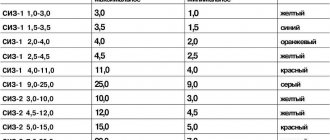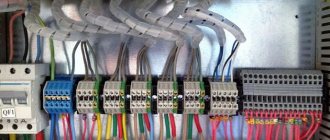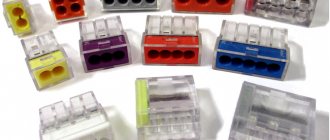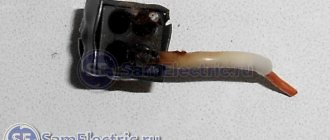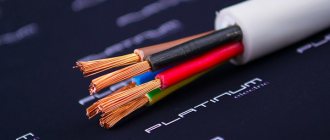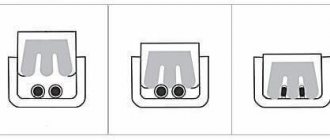It is very important to know about connectors for electrical wires, because the electrical contact depends on their quality. There are many ways to connect wires, this can be done using old methods or using terminal blocks.
When working with electrical wiring, you will always have to connect the wires. You should always be on your guard with electricity, and when connecting new electrical appliances or making repairs, you must not forget that the work must be done reliably and firmly.
Next we will talk about what connectors exist for electrical wires and how to install them with a terminal block.
Electrical contact
Electrical contact depends on the quality and reliability of the wire connection. When installing electrical wiring, it is impossible to do without connecting the wires.
- At the connection points, the electrical contacts must satisfy the following basic requirements:
- reliable contact, without additional resistance. The resistance of the connecting contact should not be greater than the resistance of the whole piece of wire;
- mechanical strength in case of tension. If the wire at the connection points is subject to random stretching, then the strength of the contact should be no less than the strength of the conductor itself.
Wire connection methods
- Twisted wire connections.
Due to its simplicity, the most common method. To do this, just take two wires, remove the insulation (for reliable twisting, at least 5 cm of insulation is removed), then the bare wires are twisted together.
The twisted bare conductors are insulated with conventional insulating PVC tape. In place of the insulating tape, you can use special “twist caps”. Twist caps are screwed onto the connected wires, thereby insulating the exposed parts and additionally pressing the electrical contact.
It is not permissible to twist wires of dissimilar metals, for example, copper and aluminum.
- Connecting wires by soldering.
Using soldering, making connections takes a little longer, but this method is more reliable than conventional twisting. When twisting contacts, no matter how good it is, the connection points have some resistance and when current flows, the twisted contacts overheat.
The consequences of poor-quality twisting are melting of the insulation at the joints, short circuit and fire. Soldering guarantees reliable electrical contact with low resistance and the necessary mechanical strength. For soldering, ordinary tin-lead solder and rosin are used.
- Using terminal blocks.
The terminal block itself is an insulating plate with contacts. Using terminal blocks, you can connect copper wires to aluminum wires. Terminal blocks, based on the method of securing wires in them, are divided into terminal blocks with a tightening screw and terminal blocks with clamping plates.
Terminal blocks in which the wires are pressed with a screw have one drawback. In them, the wire can be damaged by the twist itself when the contact is tightened. This is especially true when connecting aluminum or stranded wires.
Terminals with pressure plates are more reliable than screw terminals, since when tightened, the wire is pressed against the terminal by the plate.
- Spring terminals.
Probably the fastest and most efficient way to connect wires. To do this, the insulation is removed from the conductive core and inserted into the terminal. They differ from screw ones in that the wires are fixed not with a screw, but with a spring clamp.
Today there are a lot of spring-type clamps, the most common of them are terminal blocks. Used to connect both soft stranded and single-core wires of different sections.
These terminals can also be used to connect copper and aluminum wires. For this purpose, special “Wago” terminal blocks are used. They use contacts made of a bimetallic plate coated with a special paste that prevents oxidation of the wires.
- Branch compression.
Branch and connecting clamps, or as they are popularly called “electrical nuts,” are used to connect electrical wires to the main line without creating a break in it.
The clamp itself consists of three metal plates with screws and an insulating box in which these plates are located. Branch compression is often used to connect copper and aluminum wires, for example, to connect to an aluminum overhead line.
Basic requirements for terminal blocks for connecting wires
Various types of terminals
Electrical installation products are manufactured according to special standards and regulations. There are several requirements for terminal connectors:
- Resistant to high temperature and combustion. Materials used for the housing are self-extinguishing upon fire. Polyamide is recommended and is used by WAGO and Legrand.
- Reliable and fast fixation of contacts. It is recommended to leave sufficient cable length for communication to avoid tension.
- The properties of the clamps should not change during the period of operation.
- The size of the contact plates should prevent contact between cores of different materials. To ensure low resistance, copper and brass parts are coated with a special paste.
- Information about the main characteristics of the device is printed on the product body.
One of the essential requirements is protection against accidental access.
Terminals for connecting wires
Considering all the connecting terminals for wires produced by the industry, you should immediately make a reservation and divide the products into two types: electrical and electrical.
In fact, the difference (in current load) between the types is often small, but it still exists. This point should be kept in mind when selecting electrical terminals for installation, repair or other actions.
- When faced with the need to select electrical terminals for wires, it is better to start with the simplest designs of domestic production - reliable, durable, proven in practice more than once:
- knife;
- fork;
- ring;
- pin;
- couplings
Connections when constructing electrical circuits can be made using different methods, and terminals are just one of the options. However, this option seems to be the simplest, most convenient and even economical compared to, for example, soldering and welding, including cold welding.
Knife
These are perhaps the most common design options for products. They can often be found as part of the electrical circuits of many household appliances: irons, refrigerators, heating devices, etc.
But they are not intended for connecting conductors of power electrical wiring, for example, in residential electrical panels.
It is permissible to install this type of electrical products on conductors (multi-core) with a cross section of 0.26-6.0 mm2 by force crimping the shank. There are two types of such products: insulated and non-insulated.
The insulation is usually painted in different colors (red, blue, yellow) depending on the rated power of the terminal block. Products are used in pairs in a “father-mother” combination.
Fork
Fork-type terminals are designed for switching power and secondary circuits. These lugs are designed for subsequent fastening with screws directly to equipment or busbars. The instructions advise using them as a temporary contact or requiring frequent reconnection.
The design of the fork ends is a two-pronged fork, hence the name. This design allows for fairly simple switching without completely unscrewing the screw clamp. At the same time, when connected, it provides a fairly tight contact.
Fork lugs are available for wires with a cross-section of up to 6 mm2. The wires are attached to the terminals using the crimping method. This place, in various variations, may or may not have an insulating coating.
Ring
More reliable contact is provided by so-called ring terminals. Like their fork counterparts, they are designed to be subsequently secured with a screw clamp. But thanks to the round shape of the contact part, they provide a larger contact area and reduce the risk of tips “popping out”.
Ring terminals for wires are such a good solution that they are used not only in low-current networks, but are also a mandatory attribute of power cables of any cross-section. In this case, the method of attaching a wire or cable to lugs of this type can vary from welding and soldering to crimping.
Ring terminals are available in copper, aluminum, brass and copper-aluminium. Their cross-section can vary greatly, starting from small terminals for a C-grade screw and ending with bolts of 27 or more. In this case, terminals for low-current networks can be supplied with insulated crimp part.
Pin
This group of connecting terminals for electrical wires is made according to the principle of a detachable part, consisting of two separate elements - a plug and a socket. The plug is marked with the symbol “A”, for example, F2A.
The socket is marked with the symbol “B”, for example, F2B. Mounting on conductors with a cross section of 1.25-6.64 mm is supported. The main purpose of pin terminals is to ensure the connection of electrical conductors.
This group of mounting accessories refers to insulated products. The tail part of the terminals is covered with insulating material. Depending on the design power of the terminal block for connecting the wires, the insulator is colored accordingly.
Insulators of electrical terminals for conductors with a cross section of up to 2 mm2 are painted blue, the rest (from 2 to 6.64 mm2) are painted yellow.
What electrical connections are there?
Connections using terminal blocks can be divided into 2 types:
- Electrical;
- Electrical.
They differ slightly, but there is still a difference. Terminals vary in current load, and this factor should be taken into account when selecting products for installation, repair and other actions.
FOR REFERENCE! Electricians constantly use terminal blocks in their work. Without these components, high-quality work cannot be carried out.
When the question arises about which terminals to purchase, it is best to start with the products offered by a domestic manufacturer. Such products are considered reliable, time-tested and have a good service life.
Terminals come in the following types:
- knife;
- ring;
- coupling;
- pin.
Connections in electrical circuits can be made using different methods, and the use of “clamps” is one of the methods. This option is quite simple and convenient to work with. In addition, it does not require large financial costs, because welding or soldering connections will cost much more.
The advent of terminals has greatly simplified the work of electricians, and the quality of connections has greatly increased . Thanks to the terminals, you can quickly create connections that will be resistant to stress, and they are also protected from dust and water ingress.
The terminal presses the conductive core to the contact pad, which eliminates damage and weakening of the contact. Terminal blocks can be used not only to create linear connections, but also to connect lighting devices and power supplies.
For novice electricians and for those who connect wires on their own, the use of terminals is necessary. With their help, in case of an error, you can connect several times.
To connect using terminal blocks, no special devices (soldering iron, welding machine) are required . Work with these products is done by hand, while maintaining high accuracy and speed of work. Using a terminal block, you can connect several lines and combine the wires into groups so that the electrical wiring can be used rationally.
Coupling clamps
Another type of connecting fittings is a coupling contact clamp, made in the form of a metal tube.
The couplings are designed for installation on electrical conductors with a cross-section of 0.25-16.78 mm. Fixation is carried out by forcefully crimping part of the tube or using bolts screwed into threaded holes on the coupling body. As a rule, crimp couplings are not used for connecting single-core wires.
Electrical connection blocks
A terminal block is a special electrical installation device for connecting conductors. Any block consists of a pair (or several pairs) of metal contacts with fasteners for conductors, which are located in a dielectric housing.
The polyethylene frame is designed for several cells, inside each there is a brass tube (sleeve). The ends of the connected wires must be inserted into this sleeve and clamped with two screws. It is very convenient that as many cells are cut from the block as it is necessary to connect pairs of wires, for example, in one junction box.
But not everything is so smooth, there are also disadvantages. At room conditions, aluminum begins to flow under screw pressure. You will have to periodically inspect the terminal blocks and tighten the contacts where the aluminum conductors are fixed.
If this is not done in a timely manner, the aluminum core in the terminal block will become loose, lose reliable contact, and, as a result, spark and heat up, which can result in a fire. Such problems do not arise with copper conductors, but it would not be superfluous to periodically inspect their contacts.
Terminal blocks are not intended for connecting stranded wires. If stranded wires are clamped into such connecting terminals, then when tightening the screw under pressure, the thin wires may partially break, which will lead to overheating.
In cases where it becomes necessary to clamp stranded wires into a terminal block, it is imperative to use auxiliary pin lugs.
It is very important to choose the correct diameter so that the wire does not jump out later. The stranded wire must be inserted into the lug, crimped using pliers and secured in the terminal block.
As a result of all of the above, the terminal block is an ideal option for single-core copper wires. With aluminum and stranded ones you will have to comply with a number of additional measures and requirements.
- They have a number of advantages:
- Ease of use.
- Possibility of connecting wires from dissimilar materials.
- Protection against corrosion and other external influences.
- Reliability, strength of connections.
- Terminal blocks can have different designs. The most popular are 3 types of execution:
- screw;
- spring;
- knife;
Terminals on plastic blocks
Another very convenient wire connector is a terminal on plastic blocks. This option differs from terminal blocks in that it has a smooth metal clamp. The clamping surface has a recess for the wire, so there is no pressure on the wire from the screw being tightened. Therefore, such terminals are suitable for connecting any wires.
Everything about these clamps is extremely simple. The ends of the wires are stripped and placed between the contact and pressure plates.
Such terminals are additionally equipped with a transparent plastic cover, which can be removed if necessary.
Self-clamping terminals
Wiring installation using such terminals is simple and quick.
The wire must be inserted into the hole to the very end. There it is automatically fixed using a pressure plate, which presses the wire against the tinned busbar. Thanks to the material from which the pressure plate is made, the clamping force does not weaken and is maintained all the time.
The internal tinned busbar is made in the form of a copper plate. Both copper and aluminum wires can be fixed in self-clamping terminals. These terminals are disposable.
And if you want clamps for connecting reusable wires, then use terminal blocks with levers. They lifted the lever and inserted the wire into the hole, then fixed it there by pressing it back. If necessary, the lever rises again and the wire protrudes.
Try to choose clamps from a manufacturer that has proven itself well. The clamps have especially positive characteristics and reviews.
Screw terminal blocks
Screw connectors are widely used in the electrical industry; in fact, they are a variation of a tubular (coupling) product. They are made in the form of a rectangular tube, but with a rounded (oval) bottom. On the upper plateau of such a tube there are threaded holes into which locking screws are screwed.
The entire structure is enclosed in nylon insulation. For access to the screws, passage channels are made in the insulation body. There are two types of such terminal blocks (connectors) for connecting wires - single and group.
Screw terminal blocks for connecting wires are characterized by: pronounced mechanical strength; ability to work with cables with a cross-section of up to 25 mm; use in low current and power circuits. Working with this type of connectors is easy.
The end parts of the wires are inserted inside the brass tube and the locking screws (usually two screws) are tightened with a screwdriver. In turn, the screws press the conductor to the bottom of the metal tube.
Screw terminal blocks are one of the most common types. They are a brass sleeve with two bolts in a plastic case. Contact is ensured by bolt pressure. The body can be made of different materials - polyethylene, polyamide and polypropylene. With their help, you can connect wires with cross-sections from 0.5 mm2 to 35 mm2.
- The advantages of screw pads include:
- No special tools required (only a screwdriver is needed).
- Reusable.
- Possibility of using the required number of segments.
- Screw pads also have a number of disadvantages:
- High contact resistance.
- Low reliability (weakened by vibration).
- Restrictions on wire material.
- Installation duration.
- Requires some skill to tighten.
- Annual maintenance required.
It is not advisable to use such terminals. They have increased “fluidity”; the connection weakens over time. To avoid heating due to an increase in contact resistance, it is necessary to tighten them regularly. This creates inconvenience during operation.
Certain problems also arise with multi-core wires. With screw connections, high-quality installation can only be performed using special tips or blocks with a pressure plate. Otherwise, there is a risk of damage to the cores when tightening the screw.
Thus, single-core copper wires are most suitable for this design.
- Installation with a screw connection is very simple:
- Cut off the required number of terminals from the block (with a regular knife).
- Strip the insulation of the connected wires (5-12 mm).
- Insert the stripped ends of the wires into the terminals.
- Tighten the screws.
Dealing with this is not difficult. The main thing is to be careful when tightening screws and choose quality terminal blocks.
When choosing, you need to pay special attention to the manufacturer of the product. Today there are products from different brands on sale. It is better to use products from such well-known manufacturers as Legrand, ABB, Tridonic, Werit.
Spring type terminal blocks
The most common terminal blocks of this type are self-clamping terminal blocks from WAGO.
- The WAGO series is available in 2 versions:
- PUSH WIRE (one-piece disposable).
- CAGE CLAMP (reusable).
It is impossible to remove the conductor from disposable terminals without damaging the terminal block. Reusable ones have a convenient lever to release the conductor.
This equipment is widely used not only in industrial production, but also in domestic conditions. They are especially popular for lighting networks.
The clamping occurs using a steel spring coated with a special chromium-nickel alloy. The complex shaped spring provides a reliable, durable connection. The housing, made of polycarbonate or polyamide, can withstand a wide range of temperatures and is resistant to aggressive environments.
The terminal blocks themselves are made of tinned copper. This significantly increases the contact patch, reduces contact resistance, and protects against corrosion. In addition, WAGO can be filled with a special lubricant that provides additional protection against corrosion.
Model WAGO. WAGO is capable of connecting 2-8 conductors with a diameter of 0.5-4 mm2. They are designed for a voltage of 220 V and a current of 32 A.
All spring springs come in 2 versions - for DIN rail and standard version.
DIN-rail terminal blocks are used in control panels, control cabinets, and distribution boxes. They are used wherever there is increased vibration (for example, mechanical engineering, railway industry).
Phoniexcontact produces terminal blocks for DIN rails, designed for wires both with and without lugs with a cross-section of up to 35 mm2. It is possible to connect up to 50 wires simultaneously.
The main advantage of Phoniexcontact equipment is its versatility. You can make any assemblies. All elements fit together easily.
- Installation is extremely simple and accessible:
- First you need to prepare the conductor - strip the insulation by about 10-13 mm.
- To connect the wire, just open the clamp using a regular screwdriver, insert the conductor and remove the screwdriver. The contact will close automatically.
- Advantages of spring connections:
- Availability of a separate socket for each conductor.
- Durable, high-quality connection.
- Low contact resistance.
- Possibility of joining wires from different materials.
- Protection against corrosion and other external influences.
- No special tools required.
- No special skills required.
- Possibility of reusable use.
- Does not require annual maintenance.
- Vibration resistance.
- Free access for measuring tools.
- Potential distribution (if necessary) using jumpers.
- The disadvantages include low permissible currents.
In addition to such well-known brands as WAGO, Phoniexcontact, similar equipment is produced by Legrand and ABB.
Knife Type Terminal Blocks
Such pads are used much less frequently. Mainly for grounding and grounding circuits when installed with an unbroken current-carrying conductor. They are used to cut branches into the supporting conductor.
In addition, knife joints are widely used in audio technology. Blocks are available with a width of 5 mm for conductors with a cross section of 0.2-1 mm2, and 6 mm width for conductors with a cross-section of 1-2.5 mm2. The large contact area allows you to withstand currents up to 24 A. The color range is quite varied: yellow-green, orange, gray, blue and red.
There are disposable and reusable pads. Disposable pads include Scotchlok pads produced by 3M. In them, the joining of several wires is done by pressing with a special tool.
Their main distinguishing feature is that stripping of the conductor is not required during installation. The wire along with the insulation is inserted into the terminal block and crimped until it is completely fixed. The insulation is cut through by contacts, providing a reliable permanent connection.
- Advantages of knife terminal blocks:
- Saving installation time.
- No stripping or crimping of the wire is required.
- Secure connection thanks to a lever with a latch.
- Reliability, compactness.
- No special tool required.
- No special skills required.
- Increased electrical safety.
The only disadvantage is the high price.
The products are manufactured by such well-known manufacturers as Klemsan, Legrand, 3M, and many others.
Terminal options
Everything that we discussed above is certainly interesting, but is of little use in terms of connecting wires in intra-house electrical networks. For these purposes, ready-made terminal blocks are used, which we will consider in the second part of the article. These devices can be screw or spring - we have not yet considered the latter option, but we will definitely improve it along the way.
Advice! Sometimes it becomes necessary to connect an aluminum wire with a copper wire, but this cannot be done directly, since these metals form a galvanic couple with each other, and metal oxides can disintegrate into charged ions, and electrolysis begins, causing the metals to be destroyed. Terminal connections made of a third metal, such as brass, will help out.
All terminal blocks are usually made of brass. Inside the cases, assemblies of several terminals are placed, which allows you to connect several current-carrying wires at the same time.
There are models with a special gel pumped inside that prevents metal corrosion. As with individual terminals, the models presented below will vary in conductor cross-section and maximum load capacity.
Legrand – terminal blocks that conquered the world
Screw terminal blocks
Screw terminal blocks are very widespread in the world. In essence, the product consists of parallel-spaced couplings separated by a dielectric housing.
Such devices are sold as plates that can be divided with a knife into parts with the required number of connections. The instructions for their use are no different from the same couplings, but the presence of insulation speeds up and simplifies the work.
Aluminum wire
Interesting to know! It is not recommended to install terminal blocks of this type on aluminum wires, due to their low mechanical strength - by pressing the core, we create a point with increased resistance, which means local overheating.
- French products are very popular in the world. Their terminal blocks are not just made of brass - the metal is additionally coated with a layer of nickel, which increases the conductive properties and makes the contact connection more reliable.
- Polypropylene is used as an insulating material, which is able to maintain its technical characteristics in a fairly wide temperature range - from -25 to +100 degrees Celsius.
- At the same time, the material is quite resistant to open fire, although not for a very long time, but still.
You've probably come across many similar connectors from different manufacturers, but products from France are trusted by consumers for a reason:
Example of wire connection
- Very high mechanical strength of the connection;
- Wide range of models, up to options for wires with a cross-section of 25 mm2;
- Switching with such terminal blocks can be carried out both in conditions of low-current circuits inside living rooms and in industrial premises where the corresponding equipment is connected;
- The insulation of the terminal blocks is made in different colors, which allows you to conveniently navigate the purpose and capabilities of individual models;
- All products are certified and meet all the requirements and standards of the Russian Federation and the European Union.
We actually did a little advertising here, but this is not entirely true - the conversation was about the most famous world manufacturer. At the same time, the market offers products from other companies whose quality will not be inferior to the French.
Among such manufacturers there will be domestic manufacturers, and Turkish, and other European ones, so, if you wish, ask the seller for a quality certificate to ensure the quality of the product you are purchasing.
Packaging with terminal blocks
However, despite all the obvious advantages of such connectors, their reliability will also depend on correct installation.
Here are some tips:
- If copper and aluminum wires are connected, then it is necessary to prevent them from touching inside the terminal, due to the reasons stated above;
- If you use such connectors inside a junction box, then first of all you need to take care of the absence of mechanical stress (that is, bring the wires to a sufficient length and lay them carefully), otherwise there may be situations with weakening of the contact, which can lead to a deterioration in its quality;
- If mechanical stress on the wires cannot be eliminated, then periodically (once a year) it is recommended to inspect the connection and tighten the screws.
All Legrand terminal blocks of this type are capable of operating at a voltage of 380 Volts and can withstand a load of up to 101 Amperes.
"Wago" terminals
German quality
The disadvantage of screw connections, as you understand, is the need for periodic inspection of the connection. The next hero of our review does not have this disadvantage.
Here is a spring terminal block from a German manufacturer. Such designs provide a maintenance-free, high-quality connection of wires of different sections.
These devices are characterized by the following features:
- The connection is very vibration resistant;
- The spring exerts constant pressure on the conductors - this feature can compensate for the deformation of the conductors;
- Do-it-yourself installation is extremely simple, and all you need from a tool is what will help remove the insulation from the wire;
- The design of the terminals provides easy access for measuring tools, which is convenient when carrying out repair work.
The structure of the “Wago” terminal
- The core is fixed by a flat spring, which has a very ornate shape.
- The spring itself is made of steel and coated with an alloy of chromium and nickel.
- The cores are insulated using a polycarbonate or polyamide casing. Both materials have a wide operating temperature range and are chemically resistant to weathering and various substances.
The contact group can be made in different ways, among which the most common are PUSH WIRE and CAGE CLAMP:
Schematic structure of the terminal block
- PUSH WIRE - the connection is designed in such a way that it is applicable only to conductors of sufficient rigidity, mainly single-core. To perform the fixation, you need to strip the wire by 10-15 mm and simply push the core into the desired hole in the terminal block. Although the connection is considered permanent, it is easy to remove the wire - it is enough to twist it around the axis at the same time as pulling it out, which is not always possible.
Separable connection
- CAGE CLAMP – option used for plug-in switching. The spring structure of this terminal block is unique and patented by the company. They are suitable not only for working with single-core, but also multi-core wires. Moreover, their cross section can reach 4 mm2. To fix the wire in such a terminal block, you need to strip it by 10-15 millimeters, insert it into the hole and lower the clamping lever. In this case, the compression force of the core will depend entirely on its cross-section - this is a feature of the spring design.
The disadvantages of such connections include: a higher price, but this is not surprising, because quality always costs money, and more space that the terminals occupy.
Vago terminal blocks are produced for connecting from 2 to 8 conductors, designed for different characteristics of the wires. The operating voltage is 220 Volts, and the maximum possible load is 32 Amperes, which satisfies all requirements at home - for example, almost all sockets are designed for 16 Amps.
Terminals
Terminal blocks for connecting wires provide one undeniable advantage: they can connect cores of different metals. Both here and in other articles, we have repeatedly reminded that twisting aluminum and copper wires together is prohibited.
The resulting galvanic couple will result in corrosion processes and destruction of the connection. And it doesn’t matter how much current flows at the connection. Late or early, the twist will still start to heat up. Terminals are the way out of this situation.
Wago terminal blocks
In recent years, the market has been filled with foreign-made terminal blocks. We must pay tribute: technologically, foreign designs look more advanced compared to domestic products. It is more convenient to work with them - it is faster and easier to make connections.
But from the point of view of the reliability of connections made by a foreign product, not everything is so simple. In this regard, a domestic product often looks preferable. However, let's look at some examples.
The electrical terminals produced by WAGO deserve attention. The company's engineers have invented several attractive designs, where an ordinary terminal turns into a convenient interface for connection: Push wire, Power cage clamp, Cage clamp.
Push Wire
Push Wire technology is based on the use of the rigidity properties of an electrical conductor, due to which a completely reliable contact is obtained. This type of terminal block is most suitable for working with single-core wire. Indeed, Push Wire provides a fast connection method without any reservations.
WAGO push wire
It is enough to just strip the end of the wire (10-15 mm) and push the stripped end inside the terminal with a little force. And in order to remove the conductor just as quickly, it needs to be pulled out while simultaneously scrolling around its axis.
Two types of Push Wire connectors have been developed: For a single conductor. Under a group of conductors. The group connection configuration is designed to work with wires of lower rigidity than in the case of a single connection. A slightly different mechanical clamp design is used here.
To gain access to the conductor entry holes, some force must be applied to the push button. There are also Push wire models without a button - under the pressure action of a screwdriver.
Universal Power cage clamp
This terminal block belongs to the category of universal designs. It is made for any type of electrical wire with a cross-section of 6 – 95 mm. Structurally, the Power cage clamp is a so-called double cage, which contains a spring press and a current-carrying busbar.
Connecting electrical conductors to such terminals is done using a hex key. By rotating the key, the spring is pressed, the end of the wire is inserted under the press, then the key is turned counterclockwise. As a result, the press lowers and reliably presses the inserted end of the wire.
Stacked Cage clamp
This is a unique (WAGO patented) product that has the characteristics of a pre-assembled terminal block for wires. WAGO pre-assembled terminal blocks are designed for installation on wires with a cross-section of 0.5-35 mm2. They are well suited not only for working with single-core wires, but also with multi-core wires, regardless of the degree of thinness of the individual wires.
The Cage clamp operates simply: using a screwdriver (or a special lever in other modifications), the springy clamp is lifted, the wire is inserted under the current-carrying busbar, and then the clamp is lowered into place.
Despite the simplicity of the design, the manufacturer claims: the clamping force on the contact is adjusted automatically and directly depends on the cross-section of the wire.
Cage clamp S
Wire connector option, almost identical to the product described above. But the design of the Cage clamp S is still somewhat different. The peculiarity of the “S” modification is the ability to work with a terminal of this type without the use of any electrician’s tools.
Plus, the terminal block of modification “S” is designed for conductors of sufficiently high rigidity - stranded and single-core. It is also permissible to connect wires with metal tips to the terminal.
Working with Cage clamp S is very simple: the end (stripped) part of the conductor is inserted with some force until it stops, after which the connection is established.
Connecting terminals for wires from the Gage clamp S series have found a place in almost all modifications of group multi-row terminal blocks. They are convenient to use for the installation of numerous low-current electrical lines. However, the closed design of the Cage clamp S is also successfully used in high current circuits.
There are two modifications of the fully insulated “S” design. One involves securing the wire while pressing the plate in the frontal direction. The other is designed to perform side pressure with a screwdriver on a springy plate.
Types of individual terminals
This is what a prefabricated terminal block looks like for several cores, and individual clamps are nestled inside it
Let's get straight to the main point. Let's start with the fact that all terminals can be divided into two types: electrical and electrical.
The difference between them is small and lies in the maximum current load, so when choosing an option for a specific connection, always pay attention to this. Otherwise, the models will differ from each other in their shape and method of fixing the cables, which determines the ease of working with a particular device.
In the first part of the article we will list the simplest options for individual terminals, mostly related to electrical engineering.
Interesting to know! In addition to terminal connections, electricians use many other methods for connecting wires, for example, soldering or welding, but terminals are rightfully considered the fastest and most convenient to install.
Scabbard terminals
Such terminals usually have two connectors “male” and “female”
This terminal option can be considered the most common. Probably everyone who has ever looked inside an iron or under the hood of a car has seen them. It is considered electrical, since it is not intended for connections in power electrical circuits, that is, you will not find it in an apartment or electrical panels.
- It is possible to install such a solution on wires, mainly multi-core, with a cross-section from 0.26 to 6 millimeters.
- This is done simply - the end of the wire, stripped of insulation, is inserted into the crimp shank, after which its blades are pressed tightly to the center using pliers, thereby ensuring a reliable connection.
- Such terminal blocks for wires have mating parts; they are conventionally called “male and female”. After installing each such part on the corresponding ends of the wire, they are inserted into each other. In finished products, the male is usually hard-soldered into some part, such as a relay, so you only need the female, which is shown in the photo above.
- You can purchase two types of such terminals: with and without insulation. The color of the insulation varies and usually indicates the power of the product. The second option is more convenient to use when connecting individual wires, and then cover the connection with electrical tape or heat shrink.
Ring terminals
Another common terminal option
Here are the terminals used for screw connections of conductors. This option can also be divided into two groups, which are non-isolated.
- The first type includes models with a closed ring. To connect it, you need to completely disassemble the bolted connection, and putting on the ends to be connected, tighten everything again.
Horn terminal
- The second type is a model with a broken contour, so to speak, a fork or horn type. Similar options can be used on unassembled bolted connections - it is enough to just loosen the tie a little so that there is enough space to make contact.
It is worth noting that both versions are widely used in electrical engineering. They can be found in the same cars or, for example, in all kinds of Hi-Fi speaker systems.
However, the first type is still more common due to better technical characteristics. They can be used with wires of various cross-sections: from 0.25 to 16.8 millimeters - while the plug type is designed for a much smaller range - from 0.25 to 4.6 millimeters.
Pin terminals
Pin terminal
In fact, it also refers to the knife type of connecting wires, but unlike those discussed earlier, it has a completely different shape of connectors. The terminals are fully insulated and have two mating connectors: a plug and a socket. The connection to the wire cores is also made through a crimp shank.
Such tips can already be used in electrical circuits. They are very convenient to use in combination with screw terminal blocks, which we will discuss below. This combination is used if the wires being connected are multi-core.
Coupling terminals
Coupling connection
This type of terminals is intended for single-core wires, which means they can be used in powerful electrical circuits. A connection like the one shown in the picture above can handle significant current loads. The terminals are available in various configurations.
Similar devices are used together with wires with a cross-section from 0.25 millimeters to the largest power cables. The conductor is fixed by force crimping the cores using screws that are included in the product body.
Connecting copper and aluminum wires at home
If you need to connect copper and aluminum wires, but terminal clamps and blocks are not at hand, you can do without them. Twisting the wires in this case is not a good way out, because sooner or later the place where the copper and aluminum are twisted will oxidize and this will lead to loss of contact.
An effective solution to this problem is to use a regular nut, bolt and washer.
The reliability of this connection is in no way inferior to the terminal blocks described above. The only drawback is the bulkiness (for example, when used in a junction box) and the large amount of PVC insulating tape for reliable insulation.
Connecting wires with a terminal block
When choosing a connecting block, you should first of all take into account the amount of current that will pass through the connection point, as well as the required number of mounting terminals in the comb. As a rule, the process of connecting conductors does not cause any difficulties even for amateur electricians.
Installation is really very simple: take a block with the required cell size, cut off the required number of sections, insert the cores inside the terminal cell and use screws to clamp each of the connected conductors.
The core fixing screws should be tightened with fairly moderate force. Naturally, the insulation should first be removed from the ends of the connected conductors (it is quite enough to remove about 5 mm of insulation), and the surface of the conductor itself should be thoroughly cleaned.
The big advantage of such blocks is that, depending on the installation conditions, each segment can be cut off. However, there is one nuance here: I would not recommend clamping aluminum in such a block. When tightening, the aluminum core can be pressed by the screw itself.
If aluminum conductors are connected, the screws must be tightened with extreme care. This is due to the fact that, firstly, the aluminum core can simply break, and, secondly, as is known, aluminum has a certain fluidity under the influence of significant pressure, which after some time can lead to deterioration or complete loss of contact.
And this, in turn, is fraught with overheating of the conductor and its fire. By the way, according to the standards, absolutely all connections that contain aluminum must be tightened once a year.
Instructions for connecting wires with a clamp
Actually, the procedure for performing the work, in this case, is connecting wires using various types of clamps, simple and clear. It is quite possible to do it on your own.
The first step is to bring the working conductors to the interface. And remove the insulation at the area where it enters the clamp sleeve.
Next, carefully clean the exposed end part to a characteristic shine - it is better to choose a stripper for the job.
The procedure for stripping the end of a wire before making a connection using a screw terminal. It is worth noting that this procedure is much more convenient to perform with a special tool for removing insulation
Now you need to insert the prepared ends inside the clamp sleeve and secure.
If necessary, such a connection can be additionally insulated.
The procedure for clamping stripped parts of wires inserted into sleeves. Exactly the same operation is performed on the opposite side of the block. Often work with clamps is carried out in power panels or distribution boxes
The work of connecting conductors is even easier when using a piercing type clamp or a self-aligning spring clamp type VAGO.
